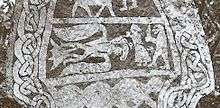Stora Hammars stones
The Stora Hammars image stones are four Viking Age image stones located in Stora Hammars, Lärbro parish, Gotland, Sweden.
.png)
Description
The four Stora Hammars image stones are phallic shaped. Similar combinations of death with this erotic symbology occur on other Gotland rune and image stones.[1] The images on the Stora Hammars II and IV stones are very worn and not currently decipherable.
Stora Hammars I
Depicted on the Stora Hammars I stone are six panels with mythological, religious and martial background, including panels depicting a woman between two men, a sacrifice scene with a Valknut over an altar, a woman standing between a longship manned with armed warriors and another group of armed men, and a battle scene.[2] Because of the position of the woman in two of the panels, it has been interpreted as illustrating the legend of Hildr and its never-ending battle.[2] The stone includes an image of a warrior about to be hanged from a tree with a Valknut nearby, considered to be Odin's cult symbol, giving validity to reports regarding human sacrifice in Norse paganism.[3] Near the altar is a shaped stone, which one scholar has been suggested may be a cult stone similar to the Elgesem runestone.[4]

Stora Hammars III
The Stora Hammars III image stone has four panels, the lower of which shows a ship with warriors. One of the panels has been interpreted as depicting Odin in the form of an eagle taking the mead of poetry,[5] a legend described in section 6 of the Skáldskaparmál.[6] Gunnlöð and Suttungr are shown to the right of the eagle. Another panel depicts a rider on a horse being greeted by a woman who has been interpreted as being a Valkyrie.[7] The woman appears to be wearing a long serk or underdress, which may be pleated, and a short overdress.[8]
See also
- Blood eagle
- Death in Norse paganism
- Tängelgarda stone
References
- Sundqvist, Olof (2005). "Aspects of Rulership Ideology in Early Scandinavia - With Particular References to the Skaldic Poem Ynglingatal". In Erkens, Franz-Reiner (ed.). Das Frühmittelalterliche Königtum: Ideelle und Religiöse Grundlagen. Walter de Gruyter. pp. 111–112. ISBN 3-11-018886-4.
- Jesch, Judith (1991). Women in the Viking Age. Boydell & Brewer. pp. 128–130. ISBN 978-0-85115-360-5.
- Patton, Kimberley Christine (2009). Religion of the Gods: Ritual, Paradox, and Reflexivity. Oxford University Press. pp. 224–225, 430 note 70. ISBN 978-0-19-509106-9.
- Antonsen, Elmer H. (1988). "On the Mythological Interpretation of the Oldest Runic Inscriptions". In Jazayery, Mohammad Ali; Winter, Werner (eds.). Languages and Cultures: Studies in Honor of Edgar C. Polomé. Mouton de Gruyter. pp. 43–54. ISBN 3-11-010204-8.
- Davidson, Hilda Roderick Ellis (1993). The Lost Beliefs of Northern Europe. Routledge. pp. 72–73. ISBN 0-415-04936-9.
- CyberSamurai Encyclopedia of Norse Mythology: Prose Edda - Skáldskaparmál Archived 2008-02-19 at the Wayback Machine (English).
- Lundin, Andreas (2006). "The Advent of the Esteemed Horseman-Sovereign". In Andrén, Anders; Jennbert, Kristina; et al. (eds.). Old Norse Religion in Long-Term Perspectives: Origins, Changes, and Interactions. Nordic Academic Press. pp. 369–376. ISBN 91-89116-81-X. pp. 370-371.
- Thunem, Hilde. "Viking Women: Underdress". Retrieved 21 August 2010.
External links
- Photograph of Stora Hammars I - Swedish National Heritage Board
- Photograph of Stora Hammars II - Swedish National Heritage Board
- Photograph of Stora Hammars III - Swedish National Heritage Board
- Photograph of Stora Hammars IV - Swedish National Heritage Board
- Photograph showing 4 stones - Swedish National Heritage Board